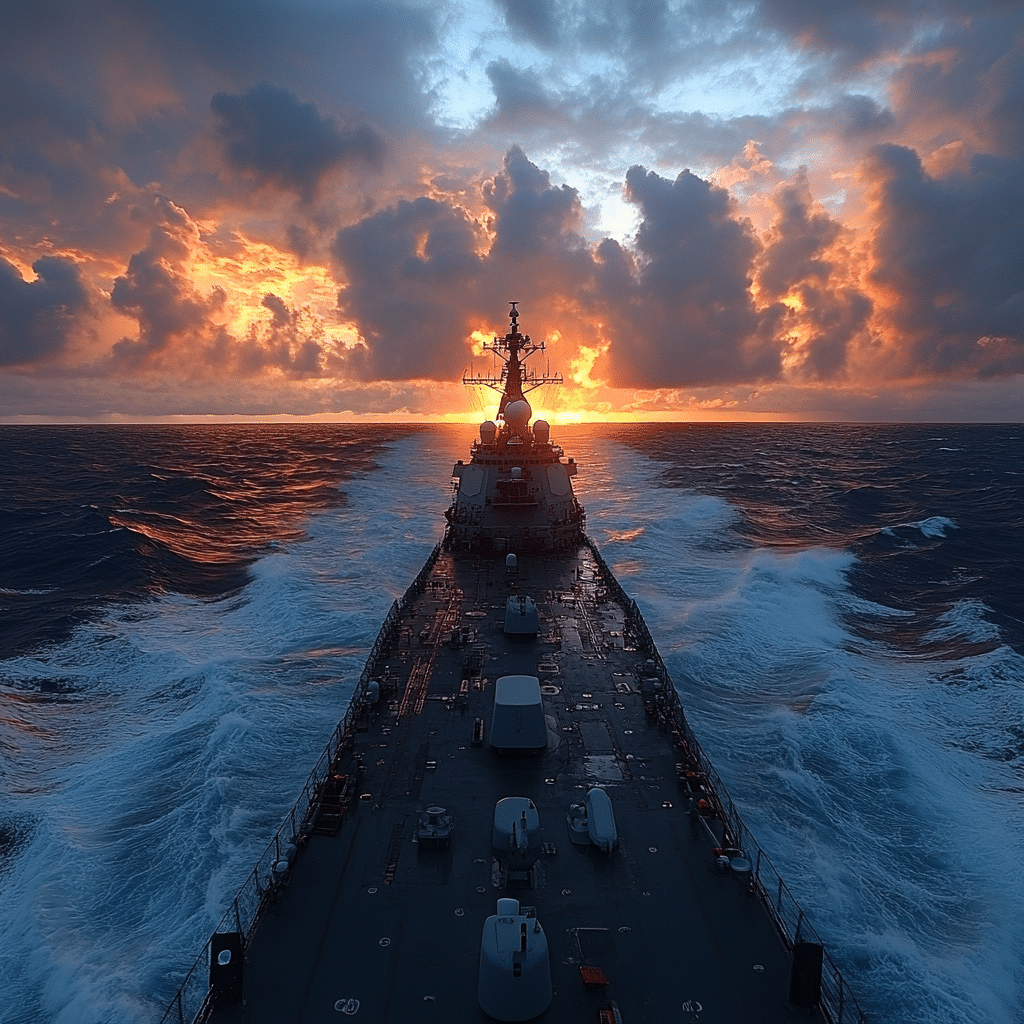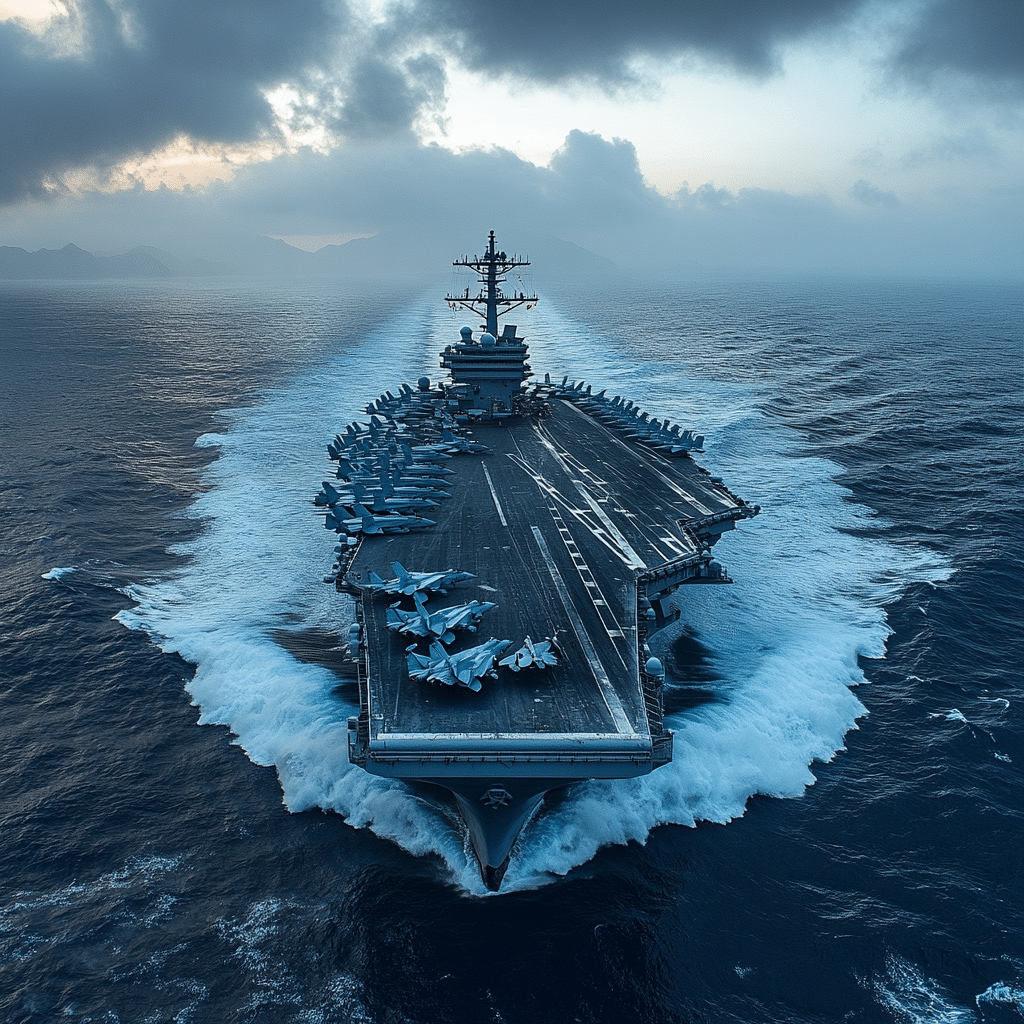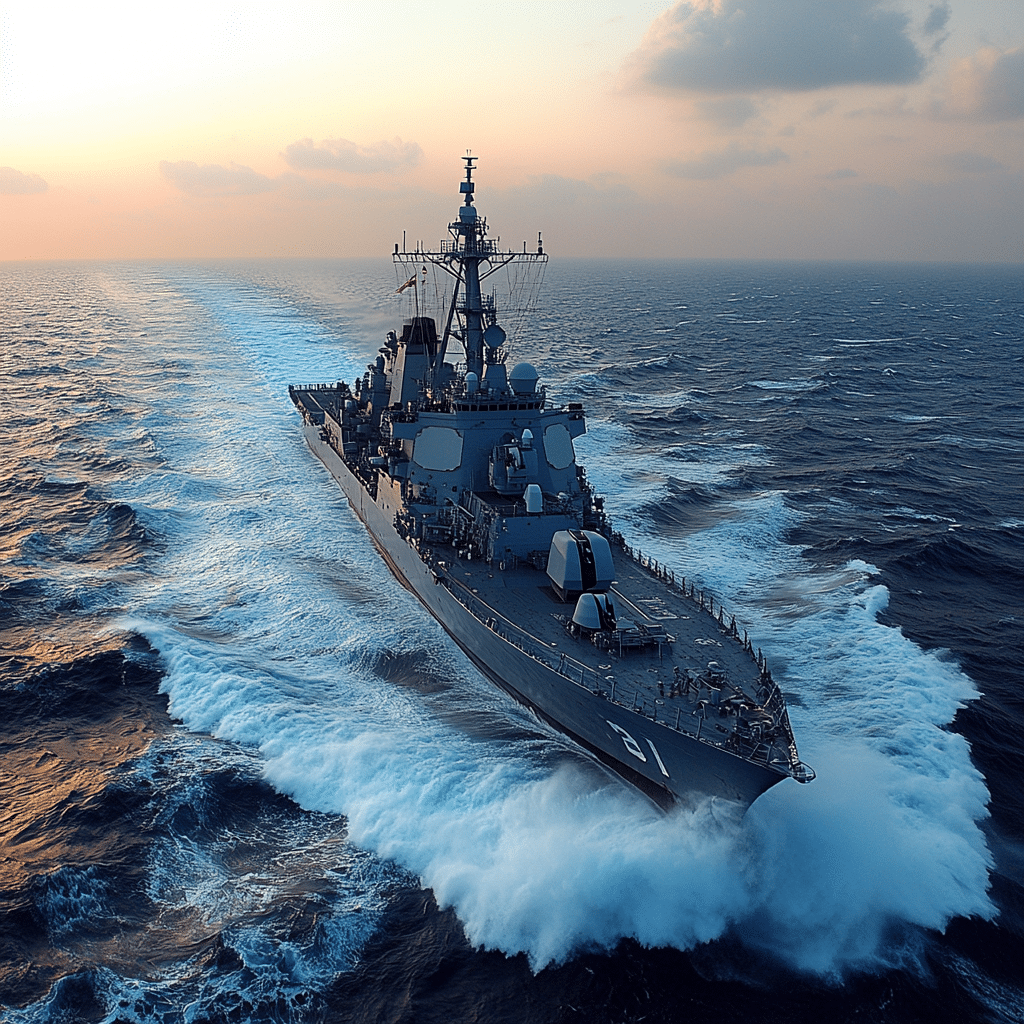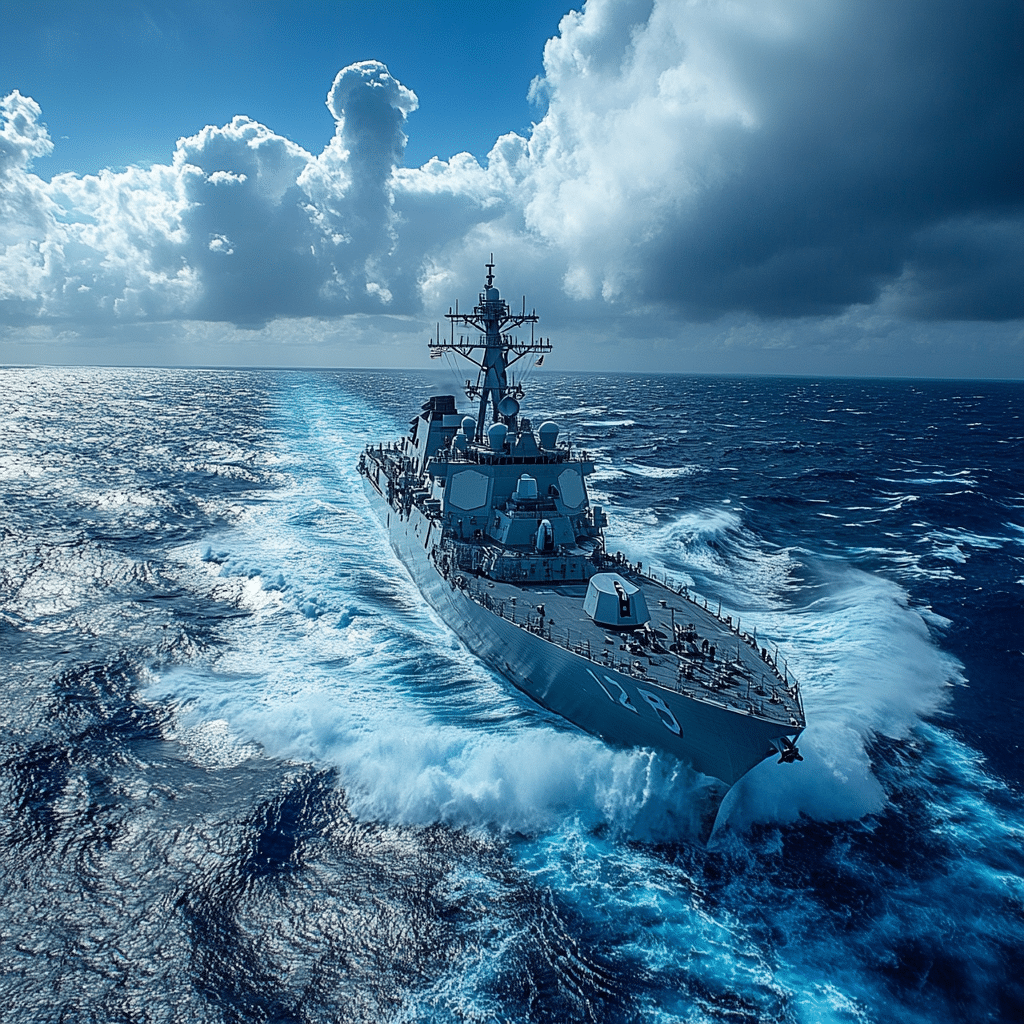The South China Sea has become a hotbed of geopolitical tensions and a battleground of military might. Recently, the US Navy ship South China Sea operations have emerged as a pivotal strategy to challenge China’s growing naval presence. China now boasts the world’s largest navy with 234 operational warships, surpassing the United States. Despite this numerical edge, the US remains a formidable force, retaining a qualitative advantage through its advanced destroyers, guided missile cruisers, and aircraft carriers. This is not just about protecting national interests—it’s about establishing a deterrent against authoritarian aggression.
1. The Strategic Importance of the South China Sea
The South China Sea isn’t just any body of water; it’s a lifeline for global trade. Over $5 trillion worth of goods pass through these waters annually. The stakes couldn’t be higher, with the US Navy’s operational presence crucial for ensuring freedom of navigation. This isn’t merely a military operation; it’s a message. The waters of the South China Sea are not the free-for-all China wants them to be.
The US Navy ship South China Sea mission shows an unwavering commitment to countering threats and supporting allies like Japan and Australia. Analysts assert that maintaining these waterways’ accessibility is not just vital for trade but also essential for upholding international laws. The unilateral imposition of restrictions by China, such as recent claims over vast areas of the South China Sea, directly conflicts with the Law of the Sea Convention, which supports the rights of all states to innocent passage through these waters.

2. The Responsive Might of the US Navy Ship Fleet
As Chinese military operations have grown bolder, the US Navy is responding decisively. They’ve ramped up their naval presence with formidable ships like the USS Ronald Reagan and the USS Nimitz. These vessels are equipped with cutting-edge technology designed to neutralize threats from Chinese nuclear submarines, sophisticated missile systems, and potential aerial assaults.
The US Navy ship South China Sea deployments are also a testament to international partnerships. Together with allies such as the Royal Australian Navy and the Japan Maritime Self Defense Force, they conduct vital exercises that bolster regional security and demonstrate military readiness. These collaborations not only enhance interoperability but also reinforce a united front against aggressive tactics by Beijing.
3. Expanding Threats: Chinese Nuclear Submarines Crash and North Korean Developments
With the rising tide of threats from Chinese nuclear submarines and provocations from North Korea, the security picture in the South China Sea is increasingly complex. Reports indicate a recent crash of a Chinese nuclear submarine near contested waters, raising serious concerns about their operational capabilities. If China’s military is struggling with such basic operational readiness, it questions the effectiveness of its sea power.
Meanwhile, North Korea’s advancements in naval technology, particularly its new nuclear attack submarines and cruise missile developments, have heightened tensions. These capabilities not only threaten South Korea and Japan but also suggest a potential military partnership with China. This alliance could unleash unprecedented challenges to US interests in the Pacific.
3.1 The Impact of North Korean Nuclear Attack Submarines
The recent display of North Korea’s nuclear attack submarines reportedly threatens to upend the established security order in the region. These showcases are designed to intimidate neighboring countries and complicate the operational landscape for the US Navy’s strategies. A coalition of North Korean and Chinese naval forces would jeopardize stability, and the implications could ripple far beyond the South China Sea.
3.2 The Role of Former CIA Analysts on South Korean Security
Insights from former CIA analysts, such as Bryan K. Lee, shed light on the multifaceted security dynamics in this region. He emphasizes that North Korea’s nuclear arsenal isn’t just a problem for South Korea. Its implications stretch globally, especially when considering North Korea nuclear attack capabilities that may extend to newly tested aerial and seaborne missile threats. These challenges require the US Navy to remain vigilant and adaptable, leading to more joint military exercises and intelligence-sharing initiatives.

4. The US Navy’s Strategic Naval Exercises in the South China Sea
Amid escalating tensions, the US Navy has initiated a series of high-profile naval exercises in the South China Sea. These operations serve dual purposes: asserting military readiness and simultaneously strengthening alliances with regional partners. Exercises like RIMPAC and Malabar have showcased enhanced collaboration among allied forces, clearly signaling to adversaries that any aggression would meet a formidable response.
These exercises also foster a spirit of cooperation and camaraderie among nations like the Philippines and Australia, creating a more cohesive defensive posture against Chinese encroachments. When the US Navy ship South China Sea plays its part in these drills, it’s not merely about showboating; it’s about sending a clear message that the United States remains deeply committed to regional security.
5. The Geopolitical Implications of US Presence in the Region
The US Navy’s operation in the South China Sea sends a strong signal to Beijing: territorial claims over disputed waters will not go unchecked. This aggressive posture has not only galvanized US allies but also attracted new partners to band together against increasing Chinese assertiveness. Countries like Japan and Australia are stepping up their military collaborations, presenting a united front that reinforces international law and order.
Moreover, the US Navy’s presence plays a critical role in countering China’s narrative of dominance. By being an active force, the US bolsters its commitment to preserving freedom of navigation and the principles of international law, making it clear that it will not allow authoritarianism to dictate maritime norms. This commitment is essential, especially when considering the implications of declining US influence and the rise of Beijing’s aggressive policies.
6. Future Prospects: Entrenching Naval Power in the Face of Escalating Tensions
Looking ahead, the US Navy must remain agile and prepared as it responds to a rapidly evolving military landscape. China’s continual advancements, particularly with its nuclear submarine fleet, necessitate a robust strategy. As the US Navy ship South China Sea maneuvers into its next mission, it can’t just rely on past successes but must innovate and adapt in the face of new challenges.
The situation demands not only military readiness but also diplomatic finesse. With ongoing developments in North Korea, alongside fluctuating ties in the region, fostering the right partnerships will be crucial. Cooperative strategies involving intelligence sharing, joint exercises, and unified political stances can create a compelling deterrent to any would-be aggressors.
Navigating Towards Stability in the South China Sea
The situation in the South China Sea continues to simmer, with nations evaluating their interests and alliances. The ongoing commitment of the US Navy serves a dual purpose: deterring military aggression while nurturing cooperation among allies. It is indeed a challenging task and speaks volumes about the complexities of international relations in 2024.
As ships sail the waters, the choices made over the coming months and years could well shape not only regional stability but also global power dynamics. Military readiness, combined with diplomatic engagement, will be key to navigating these turbulent waters. The US Navy ship South China Sea is not merely playing a role in a game of naval chess; it’s firmly embedding the principles of freedom, cooperation, and resistance against oppression into the very fabric of our strategic policy. The ongoing developments in this arena reflect a potent ideological contest and a commitment to ideals that stand against authoritarianism, shaping global relations for years to come.
US Navy Ship South China Sea: Fun Trivia and Interesting Facts
The History and Significance of US Navy Operations
The US Navy ship operating in the South China Sea has been a pivotal presence in maintaining peace and stability in the region. One fun fact is that this area is one of the world’s busiest shipping routes, with trillions of dollars in trade passing through it each year. Imagine the bustling traffic akin to managing properties in a popular area—much like popular vacation spots that are often snapped up, as seen with Rbnb rent. The importance of a strong naval presence can’t be overstated here, as it helps safeguard these economic lifelines amidst rising tensions.
But did you know that naval operations also require precise weather assessments? The US Navy leans heavily on real-time forecasts to ensure safe and efficient navigation, highlighting the critical nature of staying updated with Us weather patterns. This information enables naval forces to anticipate storms and plan their routes effectively, just like how one might pull up the latest updates before heading out for a trip.
Cultural Impact and Connections
Beyond its tactical advantages, the US Navy ship in the South China Sea often serves as a cultural ambassador. Sailors aboard frequently engage in community outreach during port visits, forging bonds that resonate with locals. Interestingly, popular culture reflects our fascination with such military displays. For instance, some might joke that just as everyone is talking about celebrities like Kate Upton in the latest gossip columns, the bravery and dedication of our service members too deserve widespread recognition.
Moreover, the symbolism of the American flag is deeply poignant. A flag displayed upside down signifies distress in military tradition— a stark reminder of the sacrifices made by service members. This military custom mirrors the broad spectrum of emotions faced during deployments, echoing stories like the heartbreaking experiences of families dealing with the death Of a sister. Just as every family has their struggles, each sailor grapples with their own reality while serving far from home.
Athleticism and Entertainment Influence
The influence of the military extends even into sports, with retired NFL stars like Rob Gronkowski often supporting the troops. Fans rally around these figures, celebrating their accomplishments while drawing parallels to the unwavering courage found aboard a US Navy ship in the South China Sea. Additionally, pop culture figures like Ashley Rickards have also been known to support military charities, creating a buzz that resonates with younger audiences.
As naval operations continue, they remind us that the challenges faced today echo throughout time. Sport and entertainment engage and inspire the public, providing a fresh perspective on the dedication shown by those in service, in a tapestry of American life. The strategic positioning of US Navy ships combines military prowess with a broader societal impact, ensuring these vessels are not just integral to national security but also to cultural identity. With PSV Eindhoven facing off against Sevilla FC in the sports arena, it’s a reminder that competition exists everywhere—whether on the seas or on the field.

Is the Chinese navy superior to the U.S. Navy?
While China has a larger number of operational warships, the U.S. Navy still holds a qualitative edge with advanced ships and technology, making it tough to say one is outright superior to the other.
How many combat ships does the Chinese navy have?
The Chinese navy has around 370 surface ships and submarines, with more than 140 major surface combatants as of October 2023.
Does the U.S. have the right to sail warships through the South China Sea?
Yes, under international law, the U.S. has the right to sail its warships through the South China Sea as part of its operations for innocent passage.
Who is the U.S. partner in the South China Sea?
In the South China Sea, the U.S. partners with several countries, including Australia, Japan, New Zealand, the Philippines, and its own Navy to conduct military cooperation activities.
Who has the strongest Navy in the world?
While China has the largest navy in terms of numbers, the U.S. Navy is generally considered to have the strongest overall capabilities.
Is China a threat to the U.S. military?
China is often viewed as a military threat to the U.S. due to its growing military capabilities and regional ambitions.
Can the US Navy defeat the Chinese Navy?
The U.S. Navy has the resources and technology to potentially defeat the Chinese Navy, especially given its qualitative advantages, though outcomes can depend on many factors.
Is Japan’s navy better than China?
Japan’s navy, while technologically advanced, is smaller in number compared to China’s. However, the effective comparison involves various aspects of naval capability and strategy.
What is the smallest navy in the world?
The smallest navy in the world is usually considered to be that of the Vatican City, which is more symbolic than functional.
What would happen if China sank a U.S. carrier?
If China were to sink a U.S. aircraft carrier, it would likely lead to severe diplomatic and military repercussions, possibly escalating tensions significantly.
Does China have warships off the coast of Alaska?
Yes, there have been reports of Chinese warships being spotted off the coast of Alaska, which raises concerns about military movements in that region.
Did China ever own the South China Sea?
China has claimed a historical ownership over parts of the South China Sea, but international law disputes this claim.
Which country rightfully owns the South China Sea?
No single country rightfully owns the South China Sea; it’s a complex mix of overlapping claims from multiple nations in the region.
Who is controlling South China Sea?
Control of the South China Sea is primarily contested, with China actively asserting its claims while several other countries also stake their own claims.
Why does China want the South China Sea?
China wants the South China Sea for its strategic importance, rich natural resources, and vital shipping routes crucial for trade and military movements.
Can the U.S. Navy defeat the Chinese navy?
The U.S. Navy has a good chance of defeating the Chinese navy, largely due to its superior technology and experience, though several variables would impact the outcome of any conflict.
Which country has the superior navy?
China currently has more aircraft carriers than the U.S., but the U.S. carriers are typically considered to be more advanced and better equipped for various operations.





































